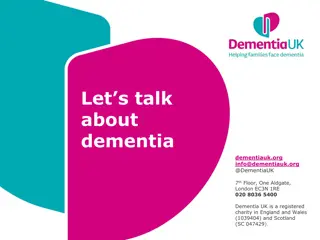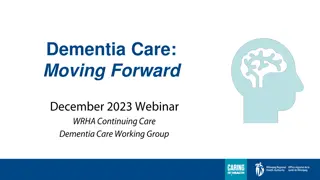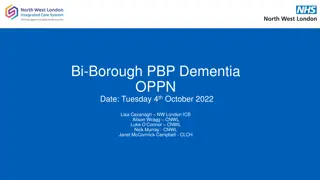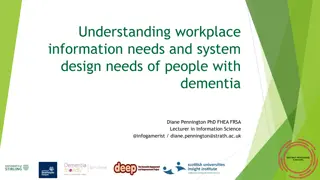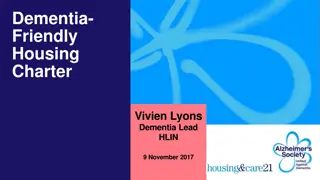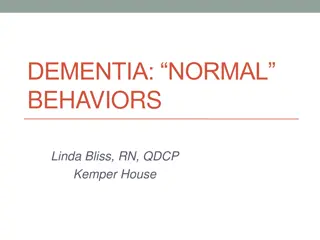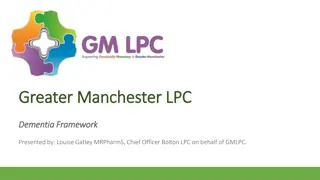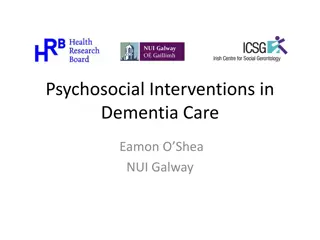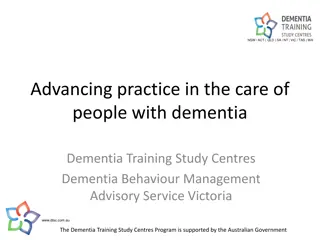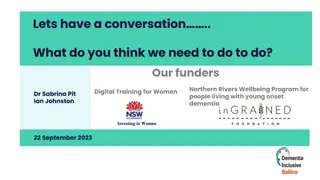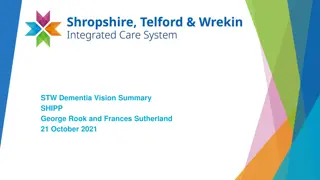Enhancing Family-Staff Partnerships for Dementia Care
Explore strategies to strengthen partnerships between families and staff in providing care for individuals with dementia. Learn about negotiation techniques, conflict resolution, and fostering a trusting partnership for improved quality of life.
Uploaded on Apr 12, 2025 | 2 Views
Download Presentation

Please find below an Image/Link to download the presentation.
The content on the website is provided AS IS for your information and personal use only. It may not be sold, licensed, or shared on other websites without obtaining consent from the author.If you encounter any issues during the download, it is possible that the publisher has removed the file from their server.
You are allowed to download the files provided on this website for personal or commercial use, subject to the condition that they are used lawfully. All files are the property of their respective owners.
The content on the website is provided AS IS for your information and personal use only. It may not be sold, licensed, or shared on other websites without obtaining consent from the author.
E N D
Presentation Transcript
Family-Staff Partnerships: Part 2 Partnerships to Improve Care and Quality of Life for Persons with Dementia
Training Goals Goals for our series Enhance family involvement in the daily care of their loved ones Promote person-centered care Goals for today Review principles of negotiation use in Step 3 Describe conflict resolution and how it works in negotiation
Family Involvement in Care (FIC) Intervention 1. 2. 3. 4. 5. Orient family to the setting and the idea of partnership Educate staff Negotiate and form partnership agreement with family Educate family members about staying involved in care Evaluate and renegotiate the agreement as needed
Step 3. Negotiation Negotiation isn t just for corporate board rooms! Negotiation is working side-by-side with another person to achieve mutually satisfying results
Step 3. Negotiation Cooperative Negotiation = Win-Win Resolve possible conflict over who controls or provides care (or parts of care!) Negotiation = Means to overcome differing views that cause conflict Negotiation = Skill that can be learned Review basic techniques Apply to partnership agreements
Step 3: Negotiation Use the law of win-win to guide decisions
Back to the beginning . . . Family Involvement in Care = A trusting partnership between staff and family in providing care for the person with dementia Deliberate process to involve family Negotiation allows family and staff to identify SHARED goals Sharing information and goals leads to a trusting partnership!
Big role change for many of staff Norm Health care providers and staff caregivers are the experts who have the answers Being EQUAL partners with family requires change How you think about your and their roles Modifying expectations and behaviors Not taking control of person s care Negotiation: plan together Help resolve conflicts Blend differing points of view
Sources of Conflict Staff and family: Different perceptions (viewpoints) Conflict: Disagreements about MOST important care activities Negotiation: Differences may trigger emotions, behaviors EMOTIONS Defensiveness Hostility Judgements BEHAVIORS Lack of knowledge Lack of follow-through Reluctance to try new things
Breakout Moment Mrs. Smith is very upset that staff part her husband s hair on the right side instead of the left. She considers this such a simple thing and easy to do and it is very important to her that he look neat and well-groomed. Staff view her concern as nitpicky and critical of them. They think she overlooks how attentive they are to getting him up, dressed in clean clothes, and hair combed before she (Mrs. Smith) arrives each day. Staff s goal: Have Mr. Smith well-groomed AND get their work done. Mrs. Smith s goal: Have her man look the way he did all of his life which helps ease her sense of loss.
Example: Sources of Conflict Defensiveness: responding to emotions instead of facts; staff thought Mrs. Smith was accusing them of poor care Hostility:acting or reacting in an unfriendly way; Mrs. Smith s view that it s such a simple thing may trigger defensiveness Judgments: Staff view Mrs. Smith as nitpicky Lack of knowledge: Neither really understood the other s view
Negotiation in dementia care Many questions and challenges in providing care & treatment Loss of abilities over time New, different demands and needs Differences in opinion are likely to emerge Values or beliefs about options/choices Real-life constraints: time, money, personnel Understanding of issues Focus on how concerns are expressed AND mutually satisfying solutions!
Negotiation in dementia care Achieving mutually satisfying results applies to lots of questions What does this behavior mean? Is this medication really helping? Or is it making things worse? What is the best way to stay engaged? What is reasonable to expect? Home health, adult day care Residential, nursing facility Primary care, specialty providers
Summary Negotiation Skill that is learned & practiced Key to avoiding conflicts Foundation for building trusting partnerships with family Shared control and power in setting goals, providing care
Coming up next Family-Staff Partnerships: Part 3 Conducting the Negotiation Session Step 5. Evaluation and Renegotiation of the Partnership Agreement


